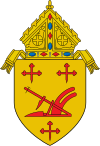
St. Paul's Episcopal Church, built in 1871, is an historic Episcopal church located at 7 Court Place at York Street in Newport, Kentucky, in the United States. On November 25, 1980 it was added to the National Register of Historic Places.
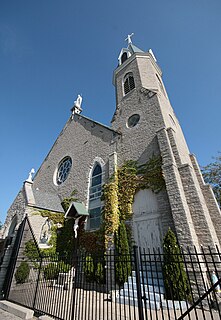
The Church of the Immaculata, or Immaculata Church, is a Roman Catholic church atop Mt. Adams, a neighborhood in Cincinnati, Ohio. The Church is located at 30 Guido Street. The church commemorates the Immaculate Conception and serves the Holy Cross–Immaculata Parish in the Archdiocese of Cincinnati. Located at 30 Guido Street, it allows a scenic view of the Ohio River below from one of the highest points in Cincinnati.

Old St. Mary's Church is a Roman Catholic church in Cincinnati's historic Over-The-Rhine neighborhood. It is the oldest continually-used house of worship in Cincinnati.
Holy Trinity Church was the first German-speaking Roman Catholic church in Cincinnati, Ohio. It was located at West Fifth Street and Mound Street in Cincinnati's historic West End. The parish was founded in 1834 and the church was dedicated on October 5, 1834.
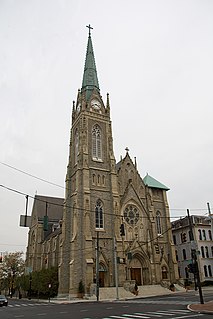
Saint Francis De Sales Catholic Church is located at 2900 Woodburn Avenue in the East Walnut Hills neighborhood of Cincinnati, Ohio, United States.
St. Augustine Church was a Roman Catholic church located at 923 Bank Street near Ailanthus Street in the old West End of Cincinnati, Ohio. The Parish patron was St. Augustine of Hippo.

St. Lawrence Church is a Roman Catholic church located at 3680 Warsaw Avenue in Cincinnati, Ohio. It was the first Catholic church in the Cincinnati neighborhood of Price Hill. The church was built on one of the highest hilltops in Cincinnati. The mother parish was St. Michael's in Lower Price Hill.

The Church of St. James the Less is a historic Episcopal church in Philadelphia, Pennsylvania, that was architecturally influential. As St. James-the-Less Episcopal Church, it was designated a National Historic Landmark for its Gothic Revival architecture, which influenced a generation of subsequent churches.

St. Boniface Roman Catholic Church was a Roman Catholic church located at 2356 Vermont Avenue in Detroit, Michigan. It was also known as St. Boniface-St. Vincent Roman Catholic Church. The church was designated a Michigan State Historic Site in 1983 and listed on the National Register of Historic Places in 1989, but was subsequently demolished.

St. Henry's Catholic Church is a historic Roman Catholic church in St. Henry, Ohio, United States. Built in the late nineteenth century, it remains the home of a functioning congregation, and it has been recognized as a historically significant building because of its architecture.

St. John the Baptist Catholic Church is a historic Roman Catholic church in Marion Township, Mercer County, Ohio, United States. Located in the unincorporated community of Maria Stein, it is the home of an active congregation and has been recognized as a historic site because of its well-preserved late nineteenth-century Romanesque Revival architecture.
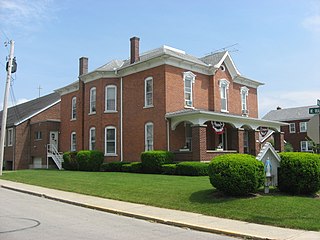
Immaculate Conception Catholic Church is a Roman Catholic parish in Botkins, Ohio, United States. Erected in 1865, the parish owns a complex of buildings constructed in a wide range of years, including two that have been designated as historic sites.

St. Sebastian's Catholic Church is a historic Roman Catholic church in Marion Township, Mercer County, Ohio, United States. Located in the unincorporated community of Sebastian, it is the home of an active congregation and has been declared a historic site because of its well-preserved early twentieth-century Gothic Revival architecture.
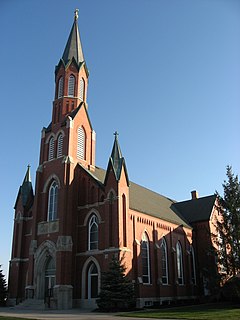
St. Rose's Catholic Church is a historic Catholic church in St. Rose, an unincorporated community in Marion Township, Mercer County, Ohio, United States.

Immaculate Conception Catholic Church is a parish of the Roman Catholic Church in Celina, Ohio, United States. Founded later than many other Catholic parishes in the heavily Catholic region of western Ohio, it owns a complex of buildings constructed in the early 20th century that have been designated historic sites because of their architecture. Leading among them is its massive church, built in the Romanesque Revival style just 43 years after the first Catholic moved into the city: it has been called northwestern Ohio's grandest church building.
The Old Church of St. Rose of Lima is a former Roman Catholic parish church which was under the authority of the Roman Catholic Archdiocese of New York, located at 36 Cannon Street between Broome Street and Delancey Street in the Lower East Side of Manhattan, New York City. The rectory was located at 42 Cannon Street; the school was located at 290 Delancey Street. The 1871 church was described by The New York Times when it opened in 1871, as one of the finest churches in the city. The church was demolished around July 1901 and the site redeveloped in conjunction with the erection of the Williamsburg Bridge (1903) and public housing. A new church was begun shortly after property was purchased in July 1900 at Grand and Lewis Streets. The parish closed in the 1960s.

Saint John the Evangelist Catholic Church is a Roman Catholic parish of the Archdiocese of Indianapolis in Indianapolis, Indiana, United States. The parish's origins date to 1837, when it was first named Holy Cross parish. In 1850 it was renamed Saint John the Evangelist parish, and is the oldest Catholic parish in the city and in Marion County, Indiana. Considered the mother of the Catholic parishes in Indianapolis, it played an important role in development of the Catholic Church in the city. Saint John's Church served as the pro-cathedral of the diocese from 1878 until 1906; its rectory served as the bishop's residence and chancery from 1878 until 1892. In 1900 the church served as the site of first episcopal consecration held in Indianapolis.

St. Mary's Catholic Church is a historic Catholic church building in an eastern neighborhood of Dayton, Ohio, United States. Constructed at the beginning of the twentieth century, it remains home to an active parish. Its grand architecture has made it an aviator's landmark, and it has been named a historic site by the federal government.

The Church of the Sacred Heart is a historic Roman Catholic church building in Freeport, Minnesota, United States. The church was constructed from 1905 to 1906 as the third and largest building to house a congregation formed by the community's German American settlers in 1881. The property was listed on the National Register of Historic Places in 1991 as Church of the Sacred Heart (Catholic) for its local significance in the theme of social history. It was nominated for demonstrating the central role played by the Catholic church in Freeport and many other Central Minnesota communities settled by German immigrants.

Saint Mary of the Assumption Catholic Church is the third oldest Catholic church building in Columbus, Ohio and is home to an active parish in the Roman Catholic Diocese of Columbus. The church's name refers to the ancient Christian belief that the mother of Jesus Christ was "assumed body and soul into heavenly glory." The church spire towers 197 feet above street level making it a prominent landmark and the tallest building in the historic German Village neighborhood south of downtown Columbus. With the rest of German Village, it was added to the National Register of Historic Places on December 30, 1974.




















